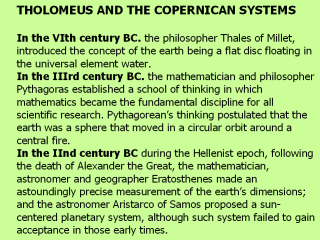| front |1 |2 |3 |4 |5 |6 |7 |8 |9 |10 |11 |12 |13 |14 |15 |16 |17 |18 |19 |20 |21 |22 |23 |24 |25 |26 |27 |28 |29 |30 |31 |32 |33 |review |
 |
In the IInd century AD under the rule of
the emperor and philosopher Marco Aurelio, Claudius Ptolemaeus proposed in
his “All Majestic or Al magesto” the idea that the earth is the center of
all the universe using the Ptolemaic system, which also had a especial
emphasis on mathematics, trigonometry, optics, and geography with the use of
latitude and longitude. In the XVIth century, Nicolas Copernicus
developed a model in which the sun (not the earth) was the center of the
universe, and he published his heliocentric model and discussed it in De
revolutionibus orbium caelestium published right before he passed away in
1543. Early in the XVIIth, Galileo adopted the heliocentric theory and published probes to support it. He was prosecuted by the Catholic Church because of defending a heretic model. But, finally in 1992 a pope’s commission acknowledged that the church was wrong. In Europe, during the high Middle Ages, artisans and merchants got organized into corporative systems in a sort of frame referred to by some authors as monopolies, to exert control on the activities they were practicing. Such groups gained prestige, social acknowledgement and economic power, which gave them political empowerment and judicial status. They were thus accepted and recognized by the local, current political or ecclesial power. Such cooperatives were known as “Universitas, Guildas or Comunitas,” which refers to a specialized group that controlled prices and the quality of products and services they provided to the community. In this manner, a new type of Universita or monopoly called University was born, which claimed for itself the right of teaching. The role of the University was to transmit, argue and discuss the knowledge of theology, philosophy, rhetoric, Greek and Hebrew, Arab or Chinese medicine, and canonical and Roman law. Such organizations were authorized and protected sometimes by monarchs or other wise by the church. In particular the University of Bologna, which was to have their pupils, promoted this corporative organization to employ as teachers, a group of intellectuals completely foreign to the clerisy or monks of the Church. Either way, at all times, curriculum contents was controlled by and under the domain of the Church, in which the material to be taught had to be adjusted under ecclesiastic supervision. The curriculum was integrated by “Tribium and Cuadrivium.” Tribium involved grammar, rhetoric, and dialectics; it was argumentation, dissertation and debate. It was addressed to monks and clerisy. Cuadrivium included arithmetic, geometry, music and astronomy. It was meant to cultivate men for the defense of theology. The purpose of those who formed the Institution called University was above all to be new men, and recuperate wisdom and knowledge that charge has had in exile. The XIIth century intellectuals revived Virgil, Plato, Aristotle, Euclid, Ptolemy, Hippocrates and Galen, to reevaluate humans as a soul-and-body duality, giving equal importance to both dimensions. Traditional monks and clerics vindicated a closeness approach to the Oriental-Hindu-Jewish mysticism. |